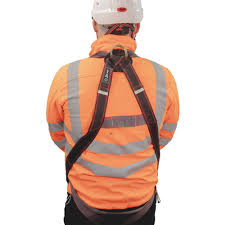The Importance of Full Body Harness and Adjustable Restraint Lanyard in Safety
When it comes to working at heights or in hazardous environments, ensuring safety is paramount. Two essential pieces of safety equipment that play a crucial role in fall protection are the full body harness and adjustable restraint lanyard.
Full Body Harness
A full body harness is a key component of personal protective equipment (PPE) designed to distribute fall arrest forces across the strongest parts of the body, such as the shoulders, chest, pelvis, and thighs. It provides support and protection in the event of a fall by preventing the wearer from hitting the ground or other lower levels.
Full body harnesses typically feature multiple attachment points for connecting to a safety line or lanyard. They are adjustable to ensure a secure and comfortable fit for different body sizes and shapes. It is important to inspect harnesses regularly for wear and tear and replace them when necessary to maintain their effectiveness.
Adjustable Restraint Lanyard
An adjustable restraint lanyard is a flexible line that connects the worker’s harness to an anchor point, allowing limited movement while preventing falls. It is used to restrict access to hazardous areas where falls could occur, providing workers with freedom of movement while ensuring their safety.
Adjustable restraint lanyards come in various lengths and configurations to suit different working environments and tasks. They are designed to absorb energy in the event of a fall, reducing the impact on the wearer’s body. Regular inspection and maintenance are essential to ensure that lanyards are in good working condition.
Conclusion
Full body harnesses and adjustable restraint lanyards are critical components of fall protection systems that help prevent accidents and injuries in high-risk work environments. Employers must provide proper training on the use of this equipment and ensure that it meets industry standards for safety.
By investing in quality full body harnesses and adjustable restraint lanyards, employers can protect their workers from falls and create a safer work environment for all. Remember, safety should always come first when working at heights or in potentially dangerous conditions.
Understanding Full Body Harnesses and Restraint Lanyards: Key FAQs Answered
- What is full body harness?
- What is a restraint lanyard?
- At what height a full body harness with a double lanyard must be used?
- What is a rule for using a full body harness?
- Is a full body harness attached to a lanyard?
What is full body harness?
A full body harness is an essential piece of safety equipment designed to protect individuals working at heights or in hazardous environments. It is a form of personal protective equipment (PPE) that secures around the wearer’s body and distributes fall arrest forces across key areas such as the shoulders, chest, pelvis, and thighs. The primary purpose of a full body harness is to prevent falls and minimize the impact on the body in the event of a fall. It typically features multiple attachment points for connecting to safety lines or lanyards, ensuring that the wearer remains securely connected to an anchor point at all times. Regular inspection and maintenance of full body harnesses are crucial to ensure their effectiveness and the safety of the user.
What is a restraint lanyard?
A restraint lanyard is a crucial safety device used in fall protection systems to prevent falls from occurring in hazardous work environments. Unlike a fall arrest lanyard, which is designed to stop a fall in progress, a restraint lanyard is used to restrict the movement of the worker and prevent them from reaching areas where a fall could happen. By connecting the worker’s harness to an anchor point, the restraint lanyard limits their access to potentially dangerous zones while allowing them enough freedom of movement to perform their tasks safely. Regular inspection and proper usage of restraint lanyards are essential to ensure optimal safety for workers at height.
At what height a full body harness with a double lanyard must be used?
When considering the use of a full body harness with a double lanyard, it is essential to adhere to safety regulations and guidelines that dictate specific working heights where such equipment must be utilised. Typically, a full body harness with a double lanyard is recommended for working at heights exceeding two meters (6.5 feet). This requirement ensures that individuals are adequately protected in the event of a fall by providing additional support and security. Employers and workers should always assess the specific risks and conditions of their work environment to determine the appropriate height at which to use a full body harness with a double lanyard, prioritising safety above all else.
What is a rule for using a full body harness?
When it comes to using a full body harness, a crucial rule to remember is to always ensure a proper fit. A full body harness should be adjusted to fit snugly and comfortably on the wearer’s body, with all straps securely fastened. It is important to follow the manufacturer’s guidelines for sizing and adjustment to ensure maximum effectiveness in the event of a fall. Regular inspections of the harness for wear and tear are also essential to maintain its safety and reliability. By adhering to these rules for using a full body harness, individuals can enhance their safety while working at heights or in hazardous environments.
Is a full body harness attached to a lanyard?
Yes, a full body harness is typically attached to a lanyard as part of a fall protection system. The lanyard serves as the connecting link between the harness worn by the worker and an anchor point, providing support and preventing falls in hazardous work environments. By securing the full body harness to a lanyard, workers are able to move freely while maintaining safety and protection in the event of a fall. It is essential for employers to ensure that proper training is provided on the correct usage and attachment of full body harnesses to lanyards to enhance workplace safety.

